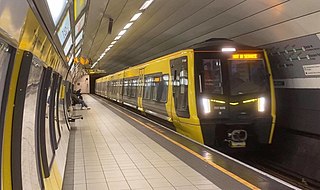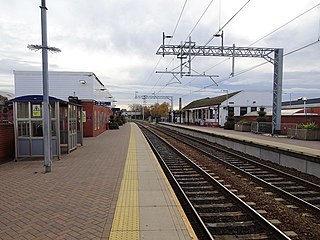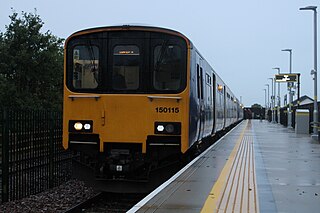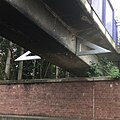
Merseyrail is a commuter rail network which serves Merseyside and adjacent areas of Cheshire and Lancashire. Merseyrail serves 69 stations, 67 of which it manages, across two lines – the Northern Line and the Wirral Line. The network uses 750 V DC third rail electrified lines having 75.0 miles (120.7 km) of routes, of which 6.5 miles (10.5 km) are underground. Since January 2023, Merseyrail commenced replacing its train fleet, withdrawing the Class 507 and 508 trains and introducing 53 new Class 777 trains. The network carried 25.5 million passengers in the 2022/2023 statistical period.

The Liverpool and Bury Railway was formed in 1845 and opened on 28 November 1848. The line ran from Liverpool Exchange first using a joint line with Liverpool, Ormskirk and Preston Railway before branching off to proceed via Kirkby then Wigan and Bolton to Bury.

Chorley railway station serves the town of Chorley in Lancashire, England. Since 2004 it has been linked with Chorley Interchange bus and coach station. It is on the Manchester–Preston line.

Wigan North Western railway station is one of two railway stations serving the town centre of Wigan, Greater Manchester, England.

Wigan Wallgate railway station is one of two railway stations serving the town centre of Wigan in Greater Manchester, England. The station serves two routes, the Manchester-Southport Line and the Manchester-Kirkby Line. It is 16 miles north-west of Manchester Victoria. The station is managed by Northern Trains, who operate all trains serving it.

Bolton Interchange is a transport interchange combining Bolton railway station and Bolton Bus Station in the town of Bolton in Greater Manchester, England. The station is located on the Manchester to Preston line and the Ribble Valley line, and is managed by Northern Trains. The station is 11+1⁄4 miles (18.1 km) north west of Manchester Piccadilly. Ticket gates have been in operation at the station since 2016.

Kearsley railway station serves the town of Kearsley and the outlying villages of Stoneclough, Prestolee and Ringley in Greater Manchester, England. It was originally named Stoneclough.

The Manchester–Preston line runs from the city of Manchester to Preston, Lancashire, England. It is largely used by commuters entering Manchester from surrounding suburbs and cities, but is also one of the main railway lines in the North West and is utilised by TransPennine Express regional services and to Scotland. It was announced in December 2009 that the line would be electrified, following an announcement in July 2009 that the Chat Moss line between Manchester and Liverpool was to be electrified first. The electrification work for this line commenced in May 2015 and was due for completion in May 2018, but was delayed until December 2018.

First TransPennine Express was a British train operating company jointly owned by FirstGroup and Keolis which operated the TransPennine Express franchise. First TransPennine Express ran regular Express regional railway services between the major cities of Northern England as well as Scotland.

The Liverpool–Wigan line is a railway line in the north-west of England, running between Liverpool Lime Street and Wigan North Western via St Helens Central station. The line is a part of the electrified Merseyrail Liverpool to Wigan City Line. The stations, and all trains serving it, are operated by Northern Trains, however the stations are branded Merseyrail using Merseyrail ticketing.

Burscough Bridge railway station is one of two railway stations which serves the town of Burscough in Lancashire, England. It is on the Manchester-Southport Line. It is operated and managed by Northern Trains. A bus interchange has recently been constructed next to the station, including a shop and cafe. The station has been identified by Merseytravel as a possible interchange between the Liverpool to Ormskirk line and the Southport to Wigan line in its Liverpool City Region Long Term Rail Strategy.

Westhoughton railway station is one of the two stations which serve the town of Westhoughton, in the Metropolitan Borough of Bolton, Greater Manchester, north-western England. The station is 15+1⁄2 miles (24.9 km) north west of Manchester Piccadilly.

Railway electrification in Great Britain began in the late 19th century. A range of voltages has been used, employing both overhead lines and conductor rails. The two most common systems are 25 kV AC using overhead lines, and the 750 V DC third rail system used in Southeast England and on Merseyrail. As of October 2023, 6,065 kilometres (3,769 mi) (38%) of the British rail network was electrified.
Weaver Junction is a railway junction connecting the West Coast Main Line (WCML) with the Weaver Junction–Liverpool line, opening on 1 April 1869. Trains bound for Liverpool from London diverge from the WCML at this junction. Weaver Junction is the oldest flying junction in Britain, and also the world.

The City Line is the brand name used by Merseytravel on suburban rail services in the Liverpool City Region starting eastwards from the mainline platforms of Liverpool Lime Street railway station.

The Kirkby Branch Line is a branch railway line from Wigan to Headbolt Lane. The line's original route was from Liverpool to Bury and later the most northern of the Liverpool to Manchester lines. The line was split at Kirkby in 1977 with the western section forming a high frequency branch of the electrified Merseyrail Northern Line, also referred to as the Kirkby branch line. The Kirkby branch to Wigan remained a low frequency diesel operated service by Northern Trains from Headbolt Lane to Manchester.

The period from 1995 covers the history of rail transport in Great Britain following the privatisation of British Rail. During this period, passenger volumes have grown rapidly, safety has improved, and subsidies per journey have fallen. However, there is debate as to whether this is due to privatisation or to better government regulation. During this period, High Speed 1, the West Coast Main Line upgrade and Crossrail were completed and more construction projects are currently under way. The period also saw the demise of privately-owned Railtrack and its replacement with government-owned Network Rail.

The Northern Hub was a rail upgrade programme between 2009 and 2020 in Northern England to improve and increase train services and reduce journey times between its major cities and towns, by electrifying lines and removing a major rail bottleneck in Manchester. It was predicted to stimulate economic growth in the region. The project had several elements but the prime objective was to eradicate the bottleneck in Manchester and allow trains to travel through the city at speed without stopping. The project was announced as the Manchester Hub in 2009. The project's steering partnership involved Network Rail, Deutsche Bahn, First TransPennine Express, Northern Rail, East Midlands Trains, CrossCountry, Freightliner, the Department for Transport, Transport for Greater Manchester and Merseytravel.
Network Rail Control Periods are the 5-year timespans into which Network Rail, the owner and operator of most of the rail infrastructure in Great Britain, works for financial and other planning purposes. Each Control Period begins on 1 April and ends on 31 March to coincide with the financial year. These periods were inherited from Railtrack, so that the earlier ones are retrospective, and not necessarily of 5 years duration.




































